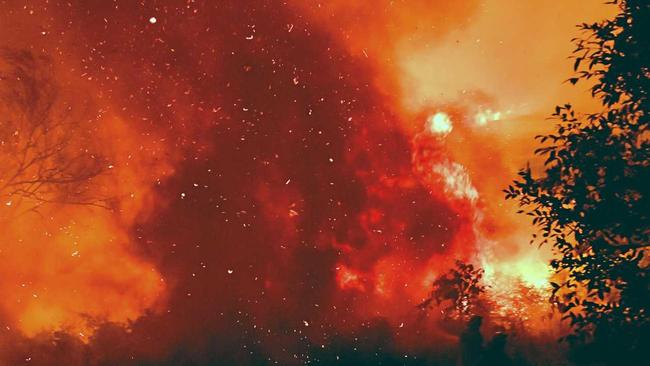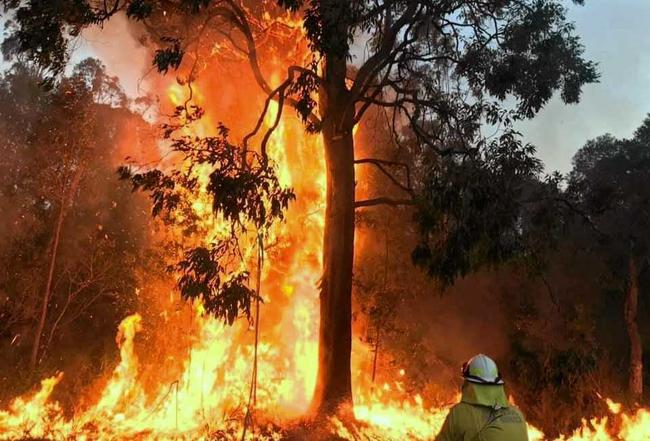The anatomy of a super fire
AS FIREFIGHTERS battle the "Armageddon" of bushfires, an expert has revealed we're facing a situation that we've never seen before.

Mackay
Don't miss out on the headlines from Mackay. Followed categories will be added to My News.
THE fires in Northern NSW are so vast and dire that an expert believes we are in "uncharted territory".
Australian Firefighters Climate Alliance spokesperson Paul Gray said fires were burning areas previously not susceptible to blazes - our rainforests.
"We're seeing unprecedented weather ... and certainly unprecedented levels of fire for this time of the year for northern New South Wales," Mr Gray said.
"In the last couple of months in southeast Queensland and in northern New South Wales fires have been burning inside the rainforest, which is certainly not a recorded event in western history in Australia.
"It normally fringes the rainforest but they have a natural capacity to prevent bush fires penetrating, and those natural defences aren't working - they're drying out so quickly that they're essentially throwing open to bushfires. And they don't recover as quickly.

"We really don't have enough records to say how they recover from fires like this."
When not on the frontline, it's difficult to imagine the courageous work of the firefighting crews. How do they extinguish these raging fires and where do they start?
It's hard work in an unpredictable environment.
In the communities, people are wondering why the fire is still burning after weeks and weeks, and whether there enough resources to tackle it.
Mr Gray describes the anatomy of a firefighting operation.
WHAT HAPPENS WHEN A BUSHFIRE BREAKS OUT
Firefighters spend a lot of time looking at historical precedents and planning for what is essentially the natural fire season, and having crews and equipment and trucks ready to go.
But when a season starts early, they can get caught a little bit unaware.
"So you have to crew up very quickly, you may rely on interstate resources," Mr Gray said.
"When you're out there fighting the fire, it's very dynamic, it's driven mostly by the front line. The people that are on the fire ground .. are trying to provide that real time information to the incident control point ... and try and dictate what the the plan of attack is, whether it's defensive or offensive.
"You have people trying to predict what direction the fire is going to move and what it might affect as it moves in that direction, given different changes in wind and weather, and if it's forecast to impact on housing, or structures or farms, they obviously have to try and get a little bit of advanced warning to people to get them to evacuate."
'OFTEN YOU'RE CHASING YOUR TAIL'
If something hasn't burnt for a long time, or has a very dense undergrowth, or is potentially going to have a canopy fire, firefighters are trying to predict what it's going to do, Mr Gray said.
"Humidity, and heat and wind are the three big factors that influence that direction and the speed of a fire but topography plays a big part in that.
"In areas that are stuck on top of ridge line, or long flat expanses, fires do tend to move very quickly when there's a wind behind it so you don't have as much time to plan, or to evacuate. So often you are you're chasing your tail for some time until you get a change of weather conditions or it it gets pulled up by some natural feature."

WHEN THERE'S NO WATER
Mr Gray said when there's a lack of water, time is your only friend.
"Often times the only thing you can do when you have a lack of water, and you have a lack of access, and you've got changing wind directions is you just have to wait it out. You have to wait until the weather conditions are favourable.
"You just have to follow the fire front, and evacuate people in front of the fire and ahead of the fire as early as you can and wait until you get favourable weather changes so you can actually attack it."
WHY ARE THE FIRES BURNING FOR SO LONG?
"When fires get to that sort of size and that scale, really getting pushed hard by the wind, all we can do is essentially fight the flank fires on the edges and hopefully wait for a change of wind direction," Mr Gray said.
"When you don't have water, you don't have many options, you just try and defend the structures that are in front of it. And if you can't defend the structures, you evacuate.
"Often times with these fires they start in inaccessible areas, and you just have to wait for them to present somewhere where there's a fire trail or somewhere where you can either back burn from or start attacking the flank of the fire and slowly start to to make to make headway on it.
" The longer something like this is, the more fatigued the crews get, the harder it is on the communities because it just draws out for weeks and weeks. Especially when you've got limited water resources, so you're water bombing aircraft rely on dams ... accessible water that's close to the fire front to be able to put it out. And if that's not around, you're very limited on options, you might have to traverse pretty long distances to secure water."
'THERE IS NOT ENOUGH CREWS'
Gray said into the future "it's a recipe for disaster" if there's no increase in numbers of firefighting crews.
"You get a few big seasons like this, it's often the same people that are responding to these incidents that have to turn around as soon as the rain starts falling and start responding to floods and swift waters," he said.
"There's been some pretty critical studies put into the need to increase volunteer numbers and professional firefighter numbers and those studies are proving to be fairly true at this point."
He said a study done around 2013 predicting most of the professional and volunteer fire brigades would need to look at doubling their workforce in a lot of these high risk areas within the 15 to 20 years was not ambitious.
But, he said, no numbers of that kind were coming to fruition.
"If anything, we're struggling to keep people within the volunteer ranks.
"It becomes a fatigue issue, a lot of the people, especially in the volunteer sphere or an ageing workforce, and it's getting harder to attract people into those roles.
"But more and more people are moving into that interface zone between the rural and the urban areas. There's more houses and more people's lives at risk in those areas."
Originally published as The anatomy of a super fire


